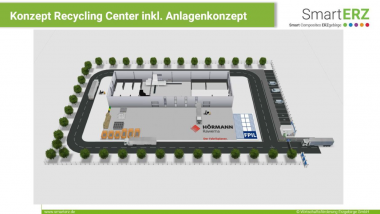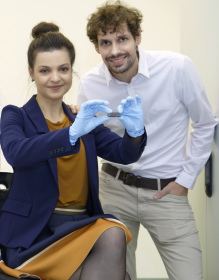Abschlussmeeting im SmartERZ-Projekt TRICYCLE
Im Februar fand im Sächsischen Textilforschungsinstitut e. V. (STFI) in Chemnitz das Abschlussmeeting des Verbundprojekts „TRICYCLE – Entwicklung und Konzeptionierung eines SmartERZ Smart Composites Recycling Centers“ statt. TRICYCLE ist ein Projekt des disziplinübergreifenden Innovationsvorhaben SmartERZ aus dem Erzgebirge, welches durch das Bundesministerium für Bildung und Forschung (BMBF) im Programm „WIR! – Wandel durch Innovation in der Region“ gefördert wird. SmartERZ ist ein branchenübergreifendes Technologiebündnis zur Entwicklung von funktionsintegrierten Faserverbundwerkstoffen.
Im Vorhaben wurde ein technologisches Recyclingkonzept für die zukünftig entstehenden smarten Produkte sowie die in der Produktion entstehenden Abfälle in der Region entwickelt. Ziel war die Entwicklung standardisierter, skalierbarer Verfahren, mit größtmöglichem Automatisierungsgrad unter Einhaltung der geltenden Gesetze, Verordnungen und Normen. Das Projekt lief vom 01.09.2021 bis 31.12.2023. Im Abschlussmeeting einer 28-monatigen Projektarbeit wurden den Teilnehmenden die Ergebnisse vorgestellt. Die Arbeit beinhaltet das Centerkonzept sowie eine Datenerhebung zu potenziell regional verfügbaren Mengen und anschließenden Verwertungsoptionen sowie die Entwicklung gewisser Designrichtlinien für das Recycling.
Eingegossen in die bestehenden Strukturen der SmartERZ Region und darüber hinaus, ist das Konzept für ein Center entstanden, welches als eine Art Drehkreuz für regionale Abfälle rund um diese Thematik fungieren soll. Darüber können Abfallströme gesammelt, erstbehandelt und für das rohstoffliche Recycling vorbereitet werden. Die Erstbehandlung schließt Technologien der Qualitätskontrolle/Qualitätsmanagement, Zerkleinerung, Pelletierung und Kompaktierung ein. Über dieses Drehkreuz sollen auch Kleinstmengen wirtschaftlich attraktiven Verwertungswegen und einer Weiterverwendung zugänglich gemacht werden.
Neben der stofflichen Vernetzung beinhaltet das Konzept für das Recycling Center die Voraussetzungen um als Vernetzungsstelle rund um die Thematik (textiler) Kreislaufwirtschaft zu fungieren. Unternehmen, Forschung, Lehre und öffentliche Einrichtungen können und sollen in Diskurs treten, um die bestmöglichen Verwertungsoptionen für entsprechende Abfälle zu finden, aber auch die Vermeidung und Wiederverwendung von Abfällen voranzutreiben, langlebige Produkte zu schaffen und Wissen zu teilen.
Die Projektpartner stimmen überein, dass nun nach Wegen gesucht werden muss, um das entstandene Konzept umzusetzen. Zusätzlich bahnen sich bereits Kooperationen mit anderen Forschungsvorhaben an. Johannes Leis als Projektleiter TRICYCLE und Dr. Stefan Minar seitens des Projekts WIRreFa sehen nun die Chance, gar die Notwendigkeit, die offensichtlichen Schnittstellen beider Projekte so schnell wie möglich zusammenzubringen. Vielleicht noch während der zweiten Phase des Projektes WIReFa.










